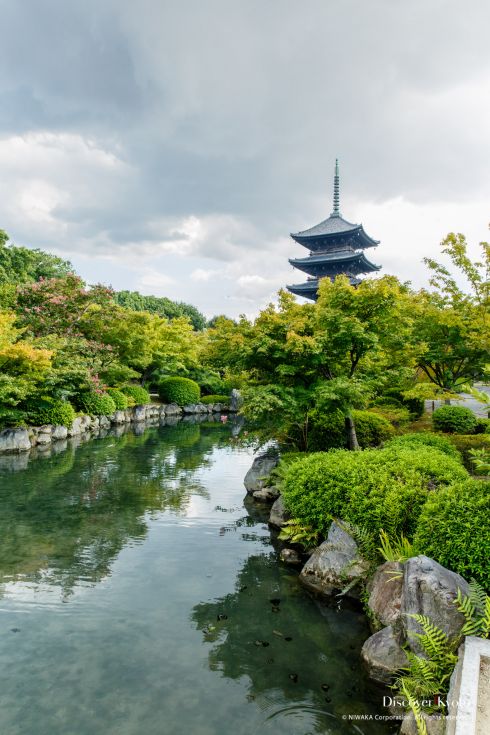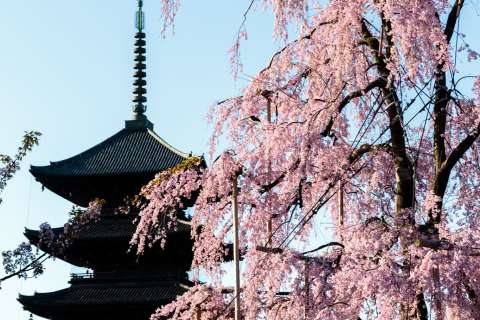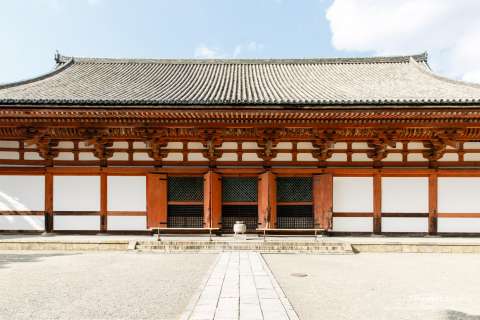Tō-ji|東寺
Overview

Tō-ji, the Eastern Temple, is all that remains of a pair of temples built in the late 700s that guarded the Rashomon Gate into Kyoto and was thought to guard against malign influence entering the capital from the south. When arriving in Kyoto by bullet train you may catch sight of a pagoda rising up out of the city near the station - and that pagoda belongs to Tō-ji, a UNESCO World Heritage Site. Other buildings of note on the grounds include the Kondō main hall and the Kodō lecture hall which house a variety of Buddhist statuary. The Miei-dō hall often hosts memorials for the Shingon sect founder Kōbō Daishi, and a statue of him stands on the temple grounds. The gardens are most pleasant during sakura and fall leaf viewing season, and on the 21st of any month a large market appears at Tō-ji from 8am to 4pm.
When arriving in Kyoto by bullet train you may catch sight of a pagoda rising up out of the city near the station- and that pagoda belongs to Tō-ji.
Features
Five-Storied Pagoda

The most famous image associated with Tō-ji is the five-story pagoda (gojū no tō) in the southeast corner of the temple grounds. Standing at 54.8 meters tall, it is the tallest wooden tower in Japan, rebuilt by the third Tokugawa Shogun after being burned down by lightning strike in the Edo period. The pagoda’s unique construction, consisting of a shinbashira central pole with the five box-like layers stacked on top of it and fitted together with wooden joints instead of nails, makes the pagoda extremely resistant to earthquakes, as it will sway but not break. The inside of the pagoda is not open every day, however, so check their website to see when they hold a special opening if you wish to see inside.
Buddhist Statuary

Beyond their towering pagoda, Tō-ji is famous amidst experts on Buddhist statuary for its amazing collection of gold and wooden statues of various Buddhist deities. Within the Kondō Main Hall are the three most venerated gods at Tō-ji, with Yakushi Nyorai, the Medicine Buddha, in the center, flanked by Nikkō Bosatsu, the Boddhisatva of the Sun, and Gakkō Bosatsu, the Boddhisatva of the Moon. Behind the Kondō is the Kodō Lecture Hall, which houses 21 different statues of Tathāgata, (Buddha who have reached enlightenment), Bodhisattva, (those who have reached enlightenment but decided to remain on earth and guide others), Wisdom Kings, and the Ten Deva Guardians of Buddhism. Among these statues are particularly rare depictions and interestingly posed statues as well, so examining the little details can be quite fascinating.
Kōbō-san Market
On the 21st of every month a market is held on the grounds of the temple in honor of the founding monk Kōbō Daishi, who passed away on the 21st of March centuries ago. Called Kōbō-san by the locals, this market is a great chance to find a lot of things you wouldn’t be able to discover together anywhere else in Kyoto, from rare antiques and Buddhist tools to more commonly used household goods and clothing. Tourists often use this flea market as a great place to shop for souvenirs like cheap kimono and traditional Japanese items, and food stalls here and there ensure that you can keep your hunger at bay in order to shop as much as you’d like. The market is generally active from 8am to 4pm, though some venders leave early depending on the season.
History
When Kyoto became the capital known as Heian-kyō in 794, Buddhist temples were initially banned on orders of the imperial government, as the capital had been moved away from Nara precisely because the Emperor did not appreciate the ever-growing influence of the powerful temples in that region. However, two years after the move in 796, the city welcomed three Buddhist temples: Tō-ji on the eastern side of the Rashōmon Gate leading straight through Kyoto towards the Heian Palace, Sai-ji on the western side of the gate, and Shingon-in located within the palace grounds. Carefully placed to protect the new capital from malign influences coming from those directions, only Tō-ji, then called Kyō-ō-gokoku-ji (The Temple for the Defense of the Nation by Means of the King of Doctrines), survives to this day.
In 823, Emperor Saga appointed the monk Kūkai (774–835), founder of the esoteric Shingon school of Buddhism, as Chief Abbot of Tō-ji. Despite the thirty years since the temple’s official founding, construction was still not yet complete on the sprawling complex. With the experienced Kūkai leading the project things began to progress much more smoothly, and Kūkai was able to gain assurances from the Emperor that the temple would be granted for the exclusive use of the Shingon School.
With a base of operations much closer to the capital center, Kūkai’s political influence grew, and as he oversaw Tō-ji he also attended to various other imperial commissions and tasks related to spreading Shingon Buddhism and building the Shingon temple complex on Mount Kōya. Kūkai died there at the age of 61 and was not buried but entombed on the mountain in a mummified state, said to be in eternal meditation awaiting the arrival of the next Buddha on Earth. Kūkai posthumously received the name Kōbō Daishi (The Grand Master Who Propagated the Buddhist Teaching) and is largely known by this name today.
After Kūkai’s passing Tō-ji finally did see completion, but lacking a famed leader it gradually faded into disrepair from the late Heian period. Tō-ji’s revival can be attributed to the rise in popularity of venerating Kūkai/Kōbō Daishi, a practice that became widespread in the Kamakura period (1185–1333). This Daishi Shinkō movement saw interest in Tō-ji revived, and it was able to once more enjoy the prestige it had under its Shingon founder.
In 1486, the temple suffered a large fire and lost many of its original wooden structures. As with many temples at the time, the architecture suffered from earthquakes, lightning strikes, and fire, with many current buildings being reconstructions completed in the Edo period. Long after the demise of its sister temple and its founder, as well as the loss of the Heian capital, Tō-ji managed to remain and was appointed a World Heritage Site by UNESCO in 1994 as part of the Historic Monuments of Ancient Kyoto. To this day it serves as an important Shingon Buddhist center along with the headquarters at Mount Kōya, as well as a popular tourist site.
Events
21st of every month | Kōbō-san Flea Market |
|---|
Access
Address
〒601-8473 京都府京都市南区九条町1
| TEL | 075-691-3325 |
| FAX | 075-662-0250 |
| WEB | http://www.toji.or.jp/en/about/index.html |
Admission
- General Admission: ¥500
- High School Students: ¥400
- Junior High School, Elementary School: ¥300
- * Admission prices change often depending on the public viewings available. Check Tō-ji’s English site to confirm.
Hours
- General Admission: 08:30 – 16:30 (March 20th – April 17th), 08:30 – 17:00 (April 18th – September 19th), 08:30 – 16:00 (September 20th – March 19th)
- Closed: No closing days
Transportation
- By Kintetsu Line ⇒ Tō-ji Station ⇒ 10 minutes walking
- From Kyoto Station ⇒ Hachijō Exit ⇒ 15 minutes walking
- By City Bus ⇒ Tō-ji Minami-mon-mae, Tō-ji Higashi-mon-mae, Tō-ji Nishi-mon-mae, or Kujō Ōmiya Bus Stops
Gallery
-




 +12
+12
